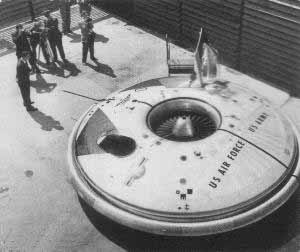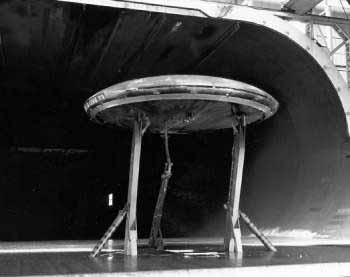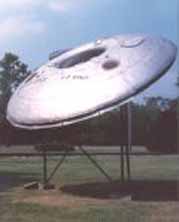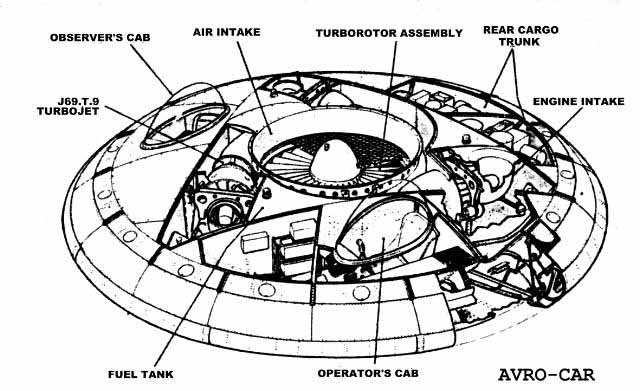

The US military was testing and flying UFO design aircraft in the 40's and 50's. They had as many as 35 saucer projects with vertical lift off and descent. The most highly classified was known by code name Silverbug.
Near the end of WWII the allied forces had gained superiorty over the Germans. Or so it seemed. The Germans were looking for a superior craft. The SSE and Vril societies were building craft that looked like UFO's and were capable of vertical take-off's and landings because most of their runways had been destroyed.
The project was headed by Dr. Richard Mehta, sometimes known as the 'Father of Saucerology'. He was hired by the German air force to build a saucer shaped craft that could vertically ascend and shoot down allied planes with rockets. Allegedly the war ended before Metha developed his ship.
The American government recruited some of the German scientists after the war to go to Canada and continue their work. Dr. Metha was one of these men. He work on a secret aircraft project at AVROW Aeronautics in Canada. These were saucer type flying machines.
These saucers were designed to 2300 miles per hour at an altitude of 80,000 feet. Though designed in 1955 the papers describing these design were not declassified until 1995. For over 40 year America's #1 top flying saucer project was top secret.
In the 1950's in Canada Avro revealed the Avrocar to the public.

In 1953 the Toronto Star reported on the development by Avro Canada of a disc-shaped VTOL (Vertical Takeoff and Landing) aircraft.
In February it was officially announced that a mock-up of the craft, designed by British engineer John Frost and developed by the Malton, Ontario plant, had been made - and indeed, photographs exist of technicians smiling from its twin cockpits.
The project of which the Avro-car was a part was originally known as Project Y, funded by Canada, but was taken over by the U.S. Air Force in late 1953 - early 1954, as their Project 606, with an interest by the US Army.
It was hoped that the vehicle, designated VZ-9V, would ascend vertically and reach flight speeds of 1,500 mph (2,400 km/hr). The President of Avro Canada wrote in Aero News that the prototype being built was so revolutionary that it would make other designs obsolete.
The craft was officially named the Avro-Car.By 1960 about 10 million dollars had been spent on the project. During tests, the aircraft could not rise more than four or five feet above the ground without becoming very unstable.
Attempts were made to design mechanisms to increase its stability without success. It was hoped that the project would consolidate the future of the A.V. Roe company, but it was discontinued in 1961, and A.V. Roe went out of business.

The prototype was placed in a military museum at Fort Eustis, Virginia. One view was that the failed project was simply window-dressing to cover tests of a captured alien flying disc.
The Avro-Car was (depending on the source of the information) 18 or 25 feet in diameter, and weighed 3600 lb.

It was powered by three centrally mounted gas turbine engines driving a 5 feet diam. central fan used for vertical takeoff. Once in the air the turbo-jet exhaust would be shifted to the rear giving the vehicle forward thrust to allow the aerodynamic body to generate lift.
Sixty years later, we have other VTOL aircraft, including circular drones with a central propeller, undoubtedly mistaken for extraterrestrial aircraft on the occasion, but we still do not have a decent supersonic flying saucer of terrestrial origin.
Project Silver Bug was the American "Black" project version of the Avro Aircraft Canada Y-2/ Private Venture 704 project that was revealed to the United States Air Force in 1955.
Project Y-2 was begun by the Canadian John Frost, who was apparently in the loop on Nazi Saucer programs and was quite fascinated by them. It involved a "radial flow jet" engine design which was simply radical for 1955. As late as 1976 people were copyrighting ideas essentially identical to this 1955 design (see US Patent # 4,193,568). This aircraft was listed as being capable of over 80,000 feet and Mach 3 and able to hover at up to 18,000 ft. without using afterburners.
Due to newspaper leaks in the mid 50's a cover story for the Y-2/Silver Bug program was leaked to "Look" magazine which, while broadly similar, disinformed the public as to the radical engine (substituting many small conventional jets for the single radial flow) and the control systems to be used.
Later in 1958 Avro Aircraft Ltd. was contracted to build a somewhat similar, small ground-cushion vehicle reminiscent of the "Look" magazine item for the USAF and US Army. I too am convinced that this "Avrocar" was constructed only for disinformation purposes while Y-2 went "Black" as a means of providing the US Gov't with "plausible deniability" and also the possibility of telling those who saw "flying saucers" that it was only that Avro vehicle.
At any rate, the Y-2 later Silver Bug item was an entirely other matter. It clearly DID go Black and the incredible performance projected by educated engineers for it really prove WHY it has been such a secret. The Saucer shape give natural "all aspect" stealth, the radial flow engine is capable of producing incredible thrust in an aerodynamically appealing shape, and the vertical take off and landing abilities gave the US the possibility of underground basing. All of these features provided the possibilty of "Cold War" winning technology in the 1950's! Clearly they didn't want the Soviets possessing any or suspecting their existence until they developed technology that could reasonably be expected to counter "stealth."
The strongest evidence that Avro built something to resemble Y-2 comes from 5.4 million dollars spent on Avro's own "Private Venture 704" including about 2 million dollars from the USA up to 1957. The Avrocar project was commenced after this time and used only 4 million or so to completion. Avro stated themselves that the first step in responding challenge of developing the Y-2 was to build the engine and the control duct system. Clearly this is where the first 5.4 million dollars went. With all that money came rumours and the Avrocar would be a great way to dispel them.
Meanwhile with the Avrocar, the project used a much less sophisticated arrangement in a much slower and lower flying design. It did prove the control system devised for the Y-2/PV 704/Silver Bug and provided publicly acceptable "proof" of the flying saucer design. It was also used to proved "proof" that the concept was not feasable.
The intial test flights revealed it was underpowered, unstable and could not transition to proper forward flight. Interestingly, recent films show the solved the instability problem.
There is testimony on the record that they also finished doing modifications required to allow the craft to transition to forward flight (after which it was expected to be capable of 300 mph). This is the date the US money disappeared and the project was terminated with all drawings, tooling, and flying examples taken to the USA. The examples at Wright Patterson and in the Smithsonian are NOT the final Avrocar version but early development models that were far from successful.
- Randall Whitcomb